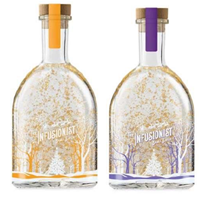Aldi gin bottle infringes M&S bottle design, says IPEC
Marks & Spencer (M&S) has succeeded in a battle with Aldi over copycat gin bottles, successfully enforcing several UK registered designs against Aldi in a decision that should provide some welcome reassurance for designers seeking to use registered designs to protect their products.
Related article
For our most recent update on this case please see our article "Aldi’s copycat gin confirmed as infringing M&S’s registered designs: Court of Appeal guidance on UK registered design infringement", published 22 March 2024.
Read moreThe gin bottles in question were Christmas-themed, and implemented gold leaf like contents.
Earlier iterations of these Christmas-themed gin bottles had been sold by M&S since September 2019. These iterations included the “Snow Globe” iteration, shown below, which turned out to be prior art for all of the UK design registrations in question.

Moving into 2020, these earlier iterations were then modified by M&S with the addition of lights inside the bottle, and with revisions to the Christmas-themed illustrations used as part of the bottle. The supermarket first registered the updated bottle designs in December 2020, which included two versions resulting in UK design registrations 6134278 and 6134280, where the integrated light feature was not apparent, as shown below.

Along with two further versions which resulted in design registrations UK 6134282 and UK 6134284, where the integrated light feature was additionally shown:

In November 2021 Aldi began selling gin containing gold flakes in a light-up bottle, as part of its “Infusionist” range. The bottles appeared as shown below:

M&S alleged that the advertising and sale of these bottles infringed itsUK registered designs. There was no counterclaim of invalidity from Aldi.
M&S argued that there were clear similarities between the sets of designs. One of the similar features identified between the two sets of designs were the identical shapes of the bottles, bearing in mind a number of different bottle shapes could otherwise have been used. Other similar elements included the identical shape of the bottles’ stoppers, the winter scene encompassing tree silhouettes, a snow effect and an integrated light.
Conversely, Aldi had pointed to differences such as the brightness of the winter scene, the lack of a stag and doe in the scene depicted on the Aldi bottle, the existence of the branding “Infusionist” and the differences between the stoppers.
His Honour Judge Hacon said that both sets of bottles were used at home, as opposed to being used at two different points of purchase; hence, there would be a potential direct comparison.
Judge Hacon said the word “Infusionist” (which may or may not be a trade mark, it was not stated) was clear enough to make an impression and had a presence and a difference from the registered designs. He further commented “I did not understand it to be in dispute that Aldi’s bottle has a “botanics” shape which is either identical to that of the RDs [registered designs] in suit or so close that it is hard to see any real difference” (see above).
Judge Hacon found that with the design corpus in mind, the similarities between the two sets of designs would appear significant to the informed user and cumulatively they would be striking. Stressing the statutory test, (whether the registered M&S designs and the Aldi bottles produce a different overall impression) Judge Hacon concluded that they did not because of the features they had in common. The differences mentioned by Aldi were considered to represent minor (and insufficient) alterations. Registered design infringement was therefore established in respect of all four of the UK design registrations.
The decision may provide welcome reassurance for designers seeking to use registered designs to protect their products but it remains to be seen whether we had heard the last of the tale. Press reports suggest that Aldi intends to appeal the decision. One potential avenue for appeal might well include the extent to which the “Snow Globe” prior art should have been determinative/further limiting on the scope of the UK design registrations.

